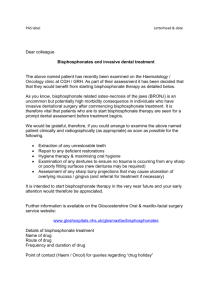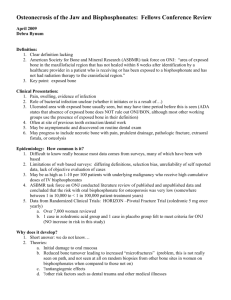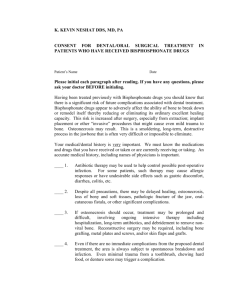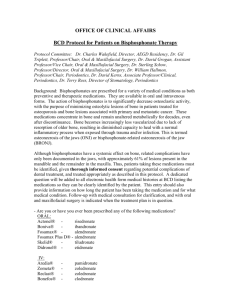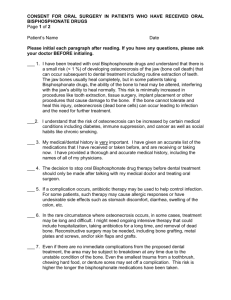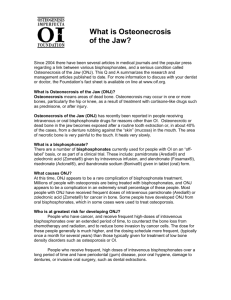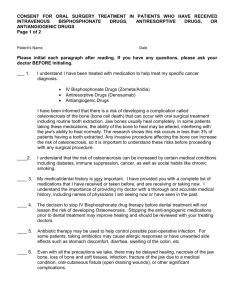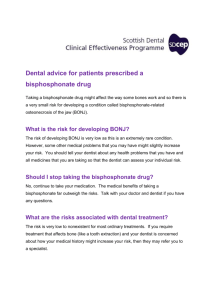Latest Guidance on Bisphosphonates
advertisement
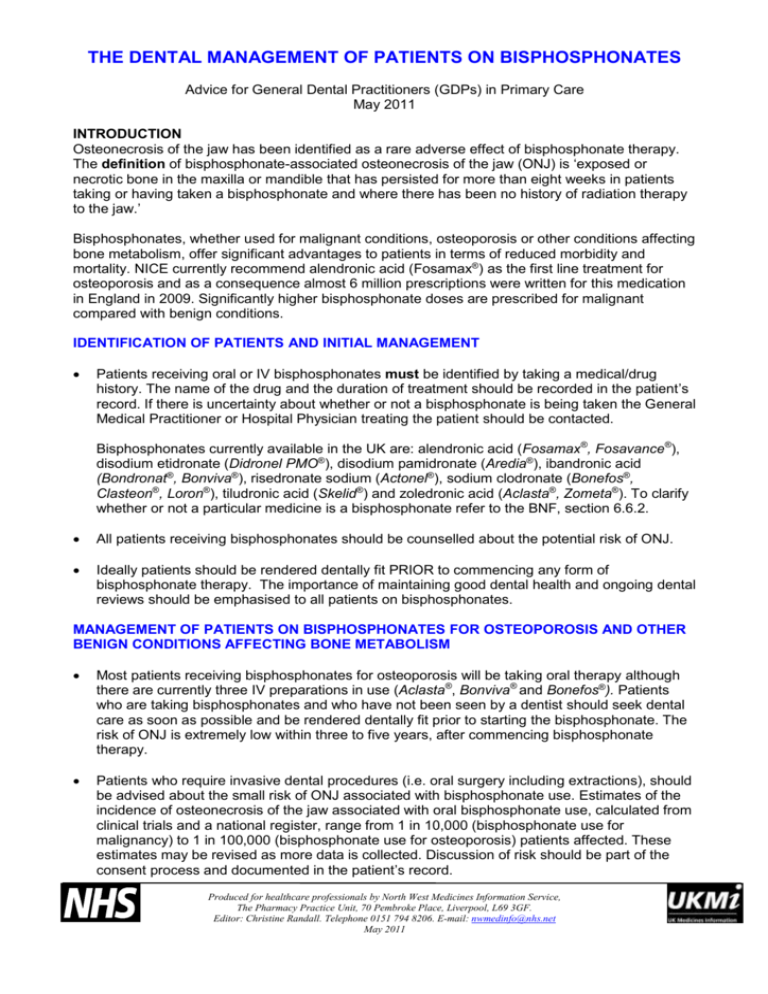
THE DENTAL MANAGEMENT OF PATIENTS ON BISPHOSPHONATES Advice for General Dental Practitioners (GDPs) in Primary Care May 2011 INTRODUCTION Osteonecrosis of the jaw has been identified as a rare adverse effect of bisphosphonate therapy. The definition of bisphosphonate-associated osteonecrosis of the jaw (ONJ) is ‘exposed or necrotic bone in the maxilla or mandible that has persisted for more than eight weeks in patients taking or having taken a bisphosphonate and where there has been no history of radiation therapy to the jaw.’ Bisphosphonates, whether used for malignant conditions, osteoporosis or other conditions affecting bone metabolism, offer significant advantages to patients in terms of reduced morbidity and mortality. NICE currently recommend alendronic acid (Fosamax®) as the first line treatment for osteoporosis and as a consequence almost 6 million prescriptions were written for this medication in England in 2009. Significantly higher bisphosphonate doses are prescribed for malignant compared with benign conditions. IDENTIFICATION OF PATIENTS AND INITIAL MANAGEMENT Patients receiving oral or IV bisphosphonates must be identified by taking a medical/drug history. The name of the drug and the duration of treatment should be recorded in the patient’s record. If there is uncertainty about whether or not a bisphosphonate is being taken the General Medical Practitioner or Hospital Physician treating the patient should be contacted. Bisphosphonates currently available in the UK are: alendronic acid (Fosamax®, Fosavance®), disodium etidronate (Didronel PMO®), disodium pamidronate (Aredia®), ibandronic acid (Bondronat®, Bonviva®), risedronate sodium (Actonel®), sodium clodronate (Bonefos®, Clasteon®, Loron®), tiludronic acid (Skelid®) and zoledronic acid (Aclasta®, Zometa®). To clarify whether or not a particular medicine is a bisphosphonate refer to the BNF, section 6.6.2. All patients receiving bisphosphonates should be counselled about the potential risk of ONJ. Ideally patients should be rendered dentally fit PRIOR to commencing any form of bisphosphonate therapy. The importance of maintaining good dental health and ongoing dental reviews should be emphasised to all patients on bisphosphonates. MANAGEMENT OF PATIENTS ON BISPHOSPHONATES FOR OSTEOPOROSIS AND OTHER BENIGN CONDITIONS AFFECTING BONE METABOLISM Most patients receiving bisphosphonates for osteoporosis will be taking oral therapy although there are currently three IV preparations in use (Aclasta®, Bonviva® and Bonefos®). Patients who are taking bisphosphonates and who have not been seen by a dentist should seek dental care as soon as possible and be rendered dentally fit prior to starting the bisphosphonate. The risk of ONJ is extremely low within three to five years, after commencing bisphosphonate therapy. Patients who require invasive dental procedures (i.e. oral surgery including extractions), should be advised about the small risk of ONJ associated with bisphosphonate use. Estimates of the incidence of osteonecrosis of the jaw associated with oral bisphosphonate use, calculated from clinical trials and a national register, range from 1 in 10,000 (bisphosphonate use for malignancy) to 1 in 100,000 (bisphosphonate use for osteoporosis) patients affected. These estimates may be revised as more data is collected. Discussion of risk should be part of the consent process and documented in the patient’s record. Produced for healthcare professionals by North West Medicines Information Service, The Pharmacy Practice Unit, 70 Pembroke Place, Liverpool, L69 3GF. Editor: Christine Randall. Telephone 0151 794 8206. E-mail: nwmedinfo@nhs.net May 2011 Routine dental treatment can be carried out in primary care and as a general rule should not be modified solely because of the patient’s treatment with bisphosphonates. Invasive dental procedures can be carried out in primary care and do not normally require referral to secondary care. Stopping the bisphosphonate prior to invasive dental procedures is not generally advocated. There is no evidence to support the reduction of ONJ risk by stopping bisphosphonate therapy prior to invasive dental procedures. However, some Hospital Physicians may recommend to individual patients that an IV infusion of bisphosophonate is postponed until after a planned, invasive dental procedure. Any decision regarding this should only be taken after consultation with the clinician treating the patient. Routine prophylactic and/or postoperative antibiotic therapy is NOT recommended unless, as for any invasive procedure, there are local or systemic risk factors for infection. There is NO evidence available that antibiotic prophylaxis reduces the incidence of ONJ following invasive dental procedures. The use of Chlorhexidine mouthwash prior to and after invasive dental procedures should be considered. There is no evidence base for this local measure. Patients should be reviewed 3-4 weeks after the procedure to ensure that the socket/surgical site has healed. Follow up should be ongoing if the socket has not healed. The presence of bisphosphonates in the bone and soft tissue may prolong healing time. Patients should be advised that if any postoperative problems (pain or unpleasant smell or taste in the mouth) develop they should return immediately to see the dentist before the next planned appointment. If healing has not taken place after 8 weeks and/or there is evidence of exposed bone, ONJ should be suspected and the patient referred to secondary care. MANAGEMENT OF PATIENTS ON BISPHOSPHONATES FOR CONDITIONS RELATED TO CANCER For the management of conditions related to cancers bisphosphonates are usually given intravenously (disodium pamidronate, zoledronic acid, ibandronic acid, sodium clodronate). However, for certain conditions oral preparations may be used (ibandronic acid, sodium clodronate). Ideally patients should be rendered dentally fit PRIOR to commencing any form of bisphosphonate therapy. This is particularly important for patients commencing treatment with an IV bisphosphonate for malignant disease. The importance of maintaining good oral hygiene and ongoing dental reviews should be emphasised. Routine dental treatment can be undertaken in primary care and should not be modified solely because of the patient’s use of bisphosphonates. Invasive dental procedures, if inevitable, should not be delayed. Advice can be sought from an Oral/Maxillofacial Surgeon or a referral made if considered necessary. Patients with additional risk factors (e.g. concurrent use of corticosteroids or other immunosuppressants) may need to be referred to secondary care for assessment and/or management. It is important that teeth/roots are retained whenever this is feasible in order to avoid invasive dental procedures. A second opinion may need to be sought from a Consultant in Restorative Dentistry or Oral/Maxillofacial Surgery. Produced for healthcare professionals by North West Medicines Information Service, The Pharmacy Practice Unit, 70 Pembroke Place, Liverpool, L69 3GF. Editor: Christine Randall. Telephone 0151 794 8206. E-mail: nwmedinfo@nhs.net May 2011 MANAGEMENT OF PATIENTS WITH SUSPECTED BISPHOSPHONATE-ASSOCIATED OSTEONECROSIS OF THE JAWS The symptoms of ONJ include delayed healing following an invasive dental procedure, pain, soft tissue infection and swelling, numbness, paraesthesia or exposed bone. Patients with osteonecrosis of the jaw should be referred to the Oral/Maxillofacial Surgery department for specialist assessment and management. If ONJ is diagnosed (see definition – Page 1) stopping the bisphosphonate may improve the chance of healing. This must only be done in discussion with the clinician treating the patient. The risks and benefits of stopping bisphosphonate therapy must be weighed against those of continuing for each individual patient. Please report ALL cases of suspected bisphosphonate-associated osteonecrosis of the jaw to the MHRA via the Yellow Card Scheme using the Yellow Cards in the BNF or online at www.yellowcard.gov.uk Information collected via the Yellow Card Scheme is used to evaluate risk, inform prescribing and improve patient safety. Authors This advice is based on recommendations initially prepared in June 2008 by Professor Anne Field (Consultant in Oral Medicine) and Dr Lesley Longman (Senior Lecturer/Honorary Consultant in Special Care Dentistry) of Liverpool University Dental Hospital and Professor Simon Rogers (Consultant Oral & Maxillofacial Surgeon, University Hospital Aintree) with later input from Professor William D Fraser (Professor of Medicine, Norwich Medical School, University of East Anglia) and Christine Randall (Medicines Information Pharmacist, North West Medicines Information Centre) Other dental hospitals/Oral/Maxillofacial Surgery departments may advise a different approach Prepared: June 2008 Reviewed: February 2009, December 2009, December 2010 Updated: May 2011 To be reviewed: May 2012 Further reading Scottish Dental Clinical Effectiveness Programme : Oral Health Management of Patients Prescribed Bisphosphonates – Dental Clinical Guidance. April 2011. NHS Evidence Oral Health - Bisphosphonates and osteonecrosis of the jaw MHRA Drug Safety Update, November 2009: Bisphosphonates: osteonecrosis of the jaw Malden N, Beltes C and Lopes V. Dental extractions and bisphosphonates: the assessment, consent and management, a proposed algorithm. BDJ 2009; 206: 93-98 BDA Factfile on Bisphosphonates. September 2008 Produced for healthcare professionals by North West Medicines Information Service, The Pharmacy Practice Unit, 70 Pembroke Place, Liverpool, L69 3GF. Editor: Christine Randall. Telephone 0151 794 8206. E-mail: nwmedinfo@nhs.net May 2011
